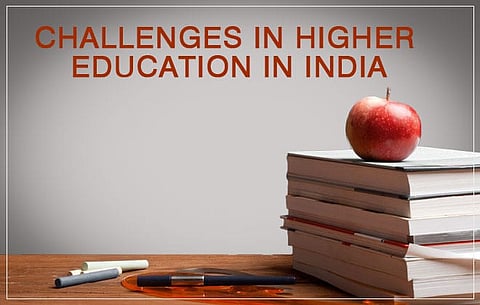

Challenges in Higher Education in India
In spite of India's flourishing GDP and the largestyouth population, India still can't leapfrog many developing countries in terms of education. Illiteracy is a roadblock to India's journey to be a superpower. With a literacy rate of 77 percent, India has moved little in terms of human development. Albeit, the GDP is roaring, thousands of citizen are living below the poverty line. Educated youths remain unemployed. The article probes into the challenges to India's higher education system.
In his column that appeared three years ago in The Hindu , Sukhadeo Thorat former UGC Chairman opined, "The first challenge to be overcome is to increase the present rate of enrolment of 20 per cent….We have only 722 universities, as against the National Knowledge Commission recommendation of 1,500. The aim should be to arrive at a proper estimate of universities and undergraduate institutions in order to plan a strategy for the next 20 years or so."
Enrollment in higher studys: India's Gross Enrollment Ratio in higher education is only 15% which is extremely low as compared to the other developing nations. Very less youths enroll in higher education. With the increase of enrollments at school level, the supply of higher education institutes is insufficient to meet the growing demand.
Economic condition of youths: Due to their economic condition, many youths can't continue their higher study. A lot of Indian citizen are below the poverty line. Though there are various social schemes for the SCs, STs and the back word classes, young students from the economically deprived society go to a job. The government needs to allocate more fund for higher studies.
Quality: India boasts of its academic excellence. The top universities have world class teaching facility. But there are many academic institute which are suffering. Those institutes are lacking qualities. India needs to ensure quality education in every institutes. There are government bodies like Ministry of HRD, UGC, NAAC etc. The government has extended full support to raise the standard of education. Many academic organizations in India are unable to meet the minimum requirements laid down by the UGC. Hardly any Indian university has made mark its place among the top universities of the world.
Poor infrastructure:The academic infrastructure in India is extremely poor. There are not enough room in schools at the villages.Colleges are running classing in school buildings. Academic institutes lack basic infrastructure. There are no library in many colleges. Even though a library is there- the collection is extremely less.
Lacking other facilities: Most of the student live in the rural areas. In many cases, they have to travel. There are no proper transport facility. The school or college doesn't have a hostel. Students can't play since their institute don't have a playground.
Student-teacher ratio: India is suffering from acute shortage of teachers. Many teaching positions remain vacant. Whereas the student strength is increasing, teachers are not being appointed adequately.
Unemployment of educated youths: There is a discouraging fact that many educated youths in India are unemployed. A large number of youth find it difficult to find a way to ensure bread and butter. This frightening scenario discourages many young students to pursue higher study.
Funding: India's premier institutes have enough founding but most of the institutes lack proper funding to sustain their projects are researches. There are very limited facilities for the researchers. Organizations like CSIR, ICSSR, DST, UGC and HRD have been trying to find a way to overcome such challenges.
Get The CEO Magazine to your Door Steps; Subscribe Now
